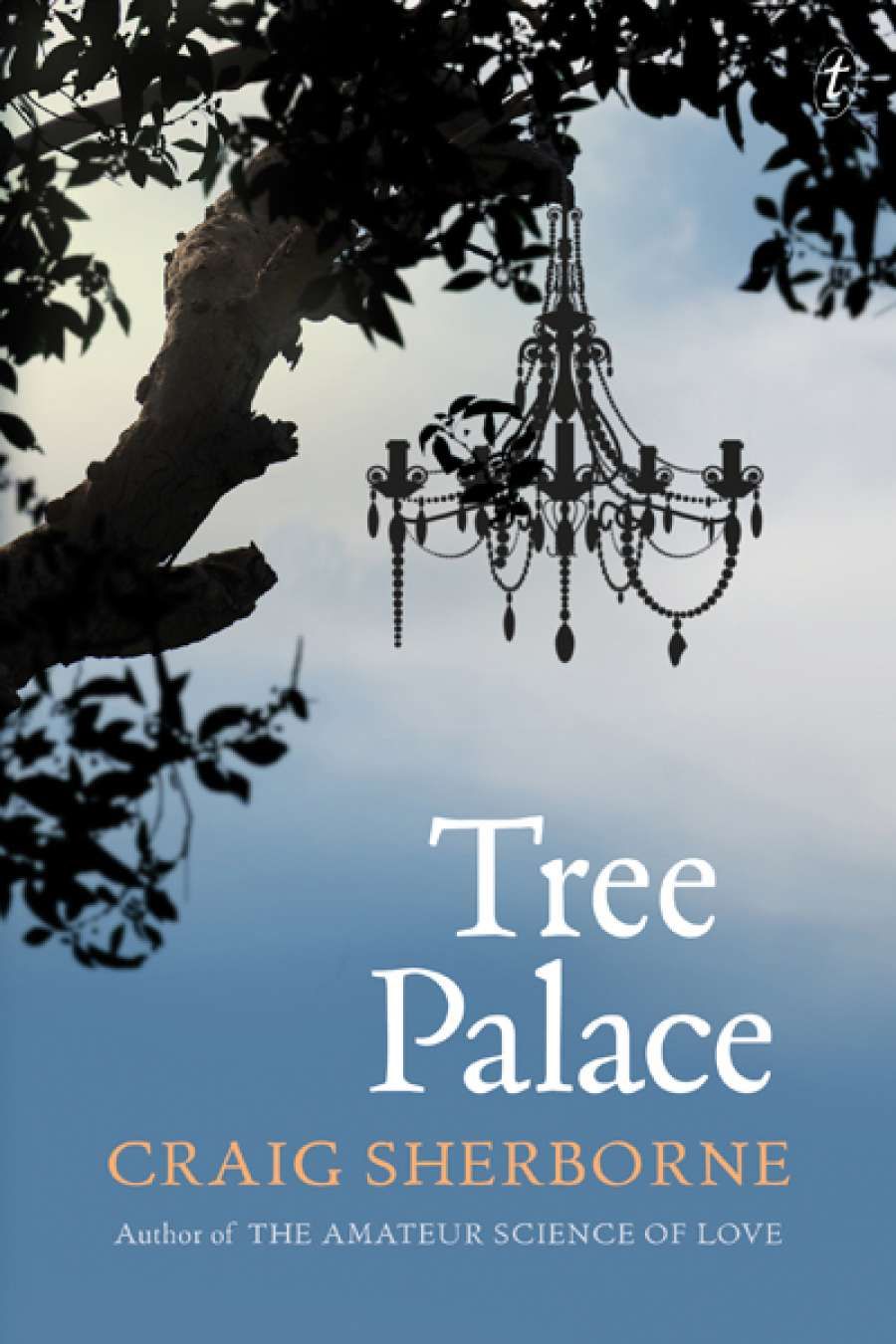
- Free Article: No
- Contents Category: Fiction
- Review Article: Yes
- Article Title: Blood lines
- Online Only: No
- Custom Highlight Text:
Craig Sherborne’s previous books include two memoirs, Hoi Polloi (2005) and Muck (2007), and an autobiographical novel, The Amateur Science of Love (2011). His second novel, Tree Palace, is an excursion outside the confines of the first-person narrative. First-person narrative does not of course always imply confinement, but in Sherborne’s case the mining of his own life experience has an intensity of focus and closeness of observation that reminds me of Lucian Freud’s painting. He has a way of pulling you into the room with him and making you look at the nakedness of others, holding you there to witness every nuance of exposure, physical and psychological. Sherborne’s fascination with bodily intimacy focuses on a sexual relationship in The Amateur Science of Love, but in the memoirs it arises from contemplation of evolving family resemblances from his youth and early adulthood through to his parents’ old age. They are a family of three, insular and closely interdependent, and the sense of confinement takes on a genetic dimension.
- Book 1 Title: TREE PALACE
- Book 1 Biblio: Text Publishing, $29.99 pb, 336 pp, 9781922147325
Watching his parents, Sherborne sees the parameters of his own physiology clearly delineated. The mystique of bloodlines haunts him. He finds himself copying his father’s mannerisms, but this is actually what leads to a turn out of the predetermining heredity: he decides to become an actor. At drama school, he trains in method acting, a Stanislavski-inspired approach in which the performer draws on personal experience in order to invest the role with an authentic emotional range. Sherborne has called himself a ‘method writer’, and the analogy certainly resonates as a way of understanding what is going on in this subtly unorthodox fictional enterprise. In the transition from memoir to autobiographical fiction to a devised fictional scenario in third-person narrative, the author continues to inhabit his characters with a method actor’s concentration, gradually extending his capacity for identification so that it encompasses a wider range of personality and physicality.
 Craig Sherborne
Craig Sherborne
In The Amateur Science of Love, the narrator evokes the figure of his female partner with such intimacy that he seems on the verge of becoming her, even as he fights for distance from the successive phases of breast cancer treatment she has to undergo. There is a claustrophobia about this intimacy, as there is in the portrayal of his parents in the memoirs, but in Tree Palace he has opened up the fictional space to allow for freer and more varied modes of identification.
Besides the move to a third-person narrative, we have the portrayal of a family that is a jigsaw puzzle, held together by solidarity rather than genealogy. Moira, the maternal figure at the centre of the story, has a teenage son and daughter by different fathers. She is now living with another man, Shane, and Shane’s half-brother Midge. It takes a while to unravel this as a reader, something Sherborne is aware of and plays with, highlighting the confusion in a comic dialogue between Moira and two police officers who are trying to sort out the identities of the various members of the household, all of whom have different surnames. Instead of a short circuit of bloodlines that threaten to strangle free will, we have a situation in which personal commitment and resilience are required to compensate for the fact that the familial relationships are all at one remove.
Method actors – think of Philip Seymour Hoffman as Capote, Daniel Day-Lewis as Christy Brown, Cate Blanchett as Bob Dylan – show a special virtuosity in crossing the natural boundaries of physicality. In a comparable way, Sherborne takes on the role of Moira and enters into confronting scenes of female intimacy. At the beginning of the story, she is returning home from the maternity hospital with her fifteen-year-old daughter Zara, who has just given birth to a boy. Zara, depressed and alienated, wants nothing to do with the baby. Moira starts by mothering the girl, trying to ration the cigarettes, cajoling her to drink chicken noodle soup; Zara scratches her itching breasts, and Moira hugs her. She has to teach this daughter to be a mother, and that means taking on the challenge of breastfeeding. It’s an awkward business, this unbuttoning of blouses, stroking, squeezing, positioning, and the narrative follows it through with unflinching concentration.
‘At the heart of the novel is a commitment to an unpredictability that arises from sheer human resourcefulness.’
Moira’s efforts, determined as they are, come to nothing on this occasion, but she never gives up, and something comes of her persistence that she never expected, taking the family dynamic in a direction the reader would not anticipate.
From time to time, the narrative point of view shifts to other members of the household. Each in his or her own way is driven by a fierce determination to make things work out, as individuals and, ultimately, as a family. This is a family that is not given, but one that has to be made and held in place through vital effort and ingenuity. What I like best about Tree Palace is its endorsement of the vitality. The story could so easily be allowed to work itself out as a piece of dismal sociology in which the losers just go on losing, but instead there is a constant dynamic turn in the sequence of events. It’s not a simple matter of optimism versus pessimism. At the heart of the novel is a commitment to an unpredictability that arises from sheer human resourcefulness.


Comments powered by CComment